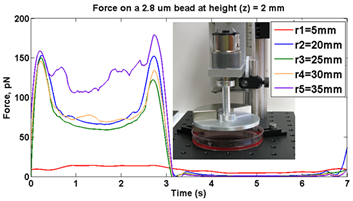Permanent Magnet Systems
Relatively simple magnetic systems have important applications in the study of forces on biological systems. In our recent cell mechanics studies of the RhoA pathway and in cancer, the studies analyze the cell lysate and bead-attached proteins after the application of forces through beads. These assays now require millions of cells, and so reproducible, quantified forces need to be applied over large areas of a cell culture dish. Ideally, the forces experienced in this system should be the same as those of our 3DFM. We can then correlate pathway experiments on cell populations with our detailed single cell measurements using the 3DFM. Our new rotating magnet system uses Neodynium magnets (JK Magnetics) mounted on a platen rotated by a DC motor. The magnets were designed with COMSOL simulation, ordered as designed by CISMM, and tested for achieving the designed forces. These systems are now in use by the Doershuck (UNC), Burridge (UNC), Jacobson(UNC) and Blobe Labs (Duke).
Inset : Design of rotating permanent magnet, disseminated to collaborators. The system has been modeled in COMSOL and verified with measurements. Here we show the vertical force during a single rotation at five different radial positions within the Petri dish.
